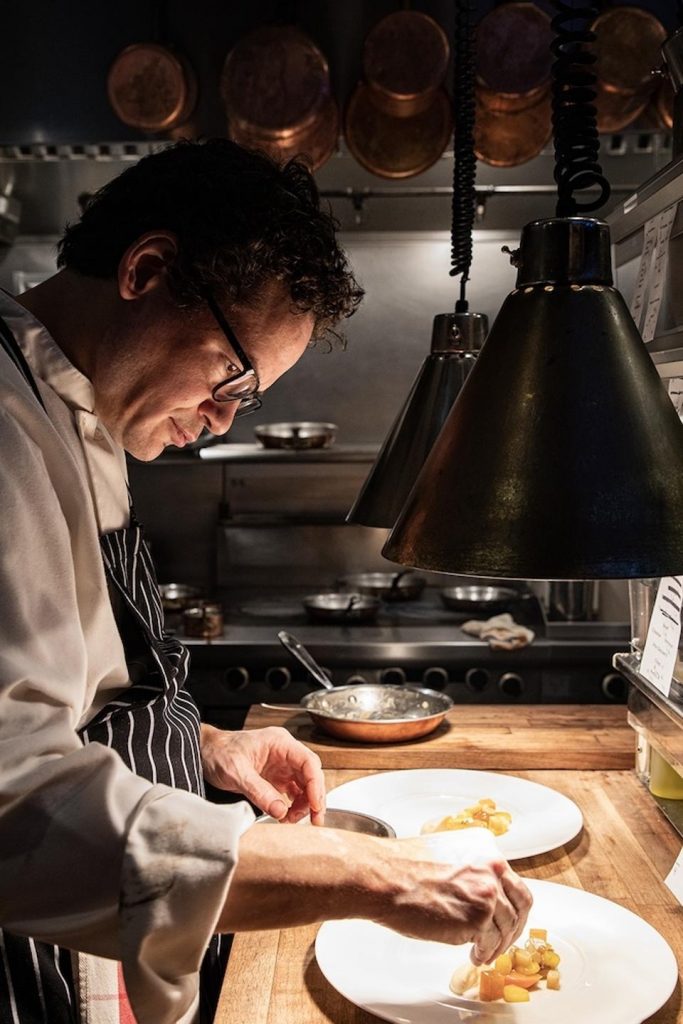Despite its refined, romantic design, its 3,000 bottle wine cache and a chef with an exceptional career and recognition, the new Saint Urban, which just opened in the Flat Iron District this May, is not an easy place to report on to readers who will not have a chance to eat anything I recommend on a menu that will be totally changed each and every month to come.
It is the same dilemma the Michelin Guide wrestled with for years in deciding whether or not to review a restaurant named Next in Chicago because the entire menu changed from Modernist Italian to Parisian 1906 to––I kid you not––interstellar space.
It is a slippery slope Chef-and Sommelier owner Jared Ian Stafford-Hill has set for himself, after relocating Saint Urban from Syracuse (where it was by default the finest restaurant in Northern New York) to a Manhattan space that once housed the wine-focused Veritas, where he once worked. Prior to that his résumé included stages at Craft, Adour by Alain Ducasse, Gramercy Tavern and Union Pacific, all in New York.
The décor is completely new and enchanting. Designed by Bentel & Bentel (they also did The Modern and Eleven Madison Park), it is not exactly minimalist but dispenses with flourishes aside from a lighted effusion of flowers and wall painting. . Largely it is done in earthen-gray stucco walls and finished oak, with splendid glowing glass-leaf sculptures overhead and slatted wood louvers evoking vine trunks. There is a pleasing contemplative ambience about the dining room, with a smaller room up at the entrance, and the focus on wine is clear from the moment you sit down. Saint Urban, by the way, was a Franco-German bishop deemed the patron of winemakers.
The whole staff is wine-imbued and very knowledgeable, as they should be with a list as long and comprehensive as St. Urban’s. Stemware varies from wine to wine and all the amenities at the table are first rate.
Stafford-Hill offers a four-course themed tasting menu at $148, seven courses at $188 and nine courses, called “Truffles and Unicorns,” at $235, plus wine pairings at three different levels of quality for $90, $175 and $410. The tasting menus are, by comparison to similar ones around New York, something of bargain––Restaurant Daniel, for instance, charges $235 for five courses; at Jean-Louis $298 for six; at Per Se $425.
I can readily say that the food, wine and service at Saint Urban are all impressive, but my remarks on what my wife and I were served are strictly based on the July menu featuring Tuscan cuisine. This was preceded by that of the Loire Valley in April; the Cȏte de Beaune in May; Spain in June; and, to come, the South of France in August and the southern Rhȏne in September. Which, of course, begs the question how can any chef, however experienced and talented, embrace so many cuisines with authority while refining them with his own take?
I can only report that we dined with pleasure in July, with all dishes matched to appropriate wines and vice-versa.
At once a puffy, olive-oil moistened rosemary-flecked focaccia and softened butter is presented while you sip a small aperitif. Three amuses bouches appeared––tender green fava beans with pecorino, lentils, oregano and olive oil; panzanella salad with a confit cherry tomato, cucumber, basil, smoked mozzarella and crouton; and braised Romano beans, with Tuscan sofrito and opal basil.
There is some choice within the courses to follow. We began with a lustrous slice of bluefin tuna (tonnato), dressed with basil and summer’s beans. There were two pastas: a rich dish of cappelletti with sweet corn, morels and a dash of pecorino. Small, tender gnocchi were arrayed in a ragù of winey wild boar.
Wonderfully flakey and velvety poached sea bass was afloat in a deeply reduced minestrone aqua pazzo, while the Livornese seafood stew called cacciucco contained ample morsels of langoustine tail and snowy cod flavored and made aromatic with fennel and lemon. (Traditionally this dish contains five species of seafood like red mullet and scallops. )
Crisp-skinned guinea hen cacciatore (hunter’s stye) with peppers and wild mushrooms was a more subtle dish than its name suggests, and then came a rectangle of beef called “alla fiorentina,” which would suggest a crusted but very rare ribeye, but this was instead closer to tournedos Rossini, in a luxuriously reduced demi-glace, almost as thick as chocolate syrup, served with eggplant, well-roasted onion and salsa verde. (Incidentally, it’s good to see sauce spoons on the table here so one can lap up every bit of such savory sauces.)
Before dessert there was a slice of fine pecorino with arugula and chestnut honey, followed by a simple olive oil cake with summer fruits and delightful ricotta sorbet.
With each of these courses carefully selected Tuscan wines were poured, from a Montenidoli Vernaccia di San Gimignano Carato 2019 and a Gaja Ca’Marcanda Vistamare 2022 to Campriano Chianti Classico Riserva 2012 s Fontodi Chianti Classico 2008 and a Casanova della Spinetta Toscana Sassontino 2006, among others.
It was a meal to applaud, and I would have loved for you, the reader, to have the opportunity to enjoy it, too, but you may have to wait another summer to do so. I can readily understand why high-caliber chefs like Stafford-Hill want to showcase their command and technique in a wide array of dishes, and, had the word “Tuscan” been taken off the July menu, it might have been served as a meal of the season. But I’m afraid you’re on your own if you go this month or next or the one after that. Let me know how it is.
Saint Urban
43 East 20th Street
646-988-1544
Open Tues.-Sat. for dinner.

